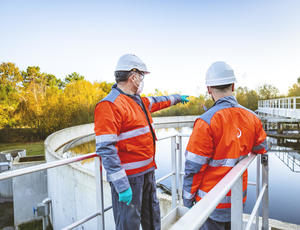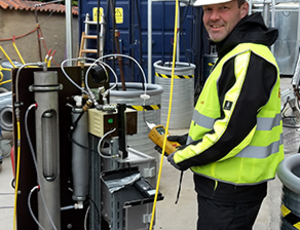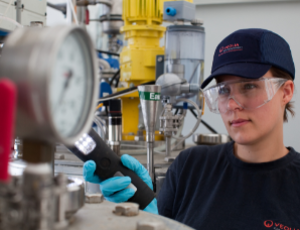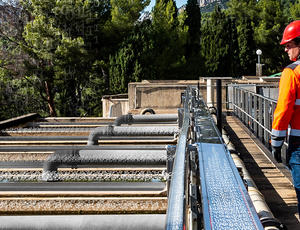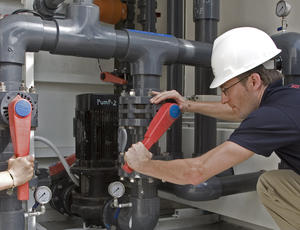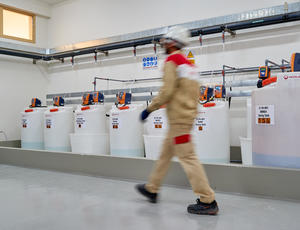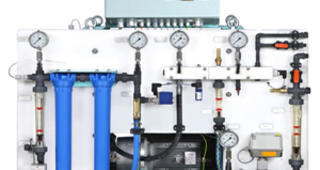The Sulfate Removal Process (SRP) extracts the sulfates from seawater prior to injection and utilizes a mix of technologies
Overview
The Sulfate Removal Process (SRP) extracts the sulfates from seawater prior to injection into the oil-bearing reservoir. SRP utilizes state-of-the-art nanofiltration membranes to selectively remove sulfate from injection seawater while leaving other salts (sodium, chloride, etc.) substantially unaffected, thus maintaining the stability and permeability of the formation clays. This economical and efficient prevention of scale avoids the need for chemical or mechanical intervention.
How does the Sulfate Removal Process work?
To minimize the volume of feed seawater required, the sulfate removal membranes are configured in a two-to-one brine array.
Optimization of the feed-to-product ratio at circa 75%
The seawater feed is introduced to the first array of membranes, allowing 50% of the feed to pass through the membrane material while rejecting sulfates on the membrane surface. The 50% reject water (brine) is then fed to the second array of membranes, where a further 50% passes through as low sulfate water.
The two flows of low sulfate water are blended to achieve an impressive overall recovery rate of 75%. The 75% low sulfate seawater is injected into the formation, while the remaining 25% of high sulfate reject is discharged overboard safely without endangering the environment.

Features and benefits

Reduces seawater sulfate (SO4) concentration

Meets the stringent design and environmental criteria related to offshore platforms

Reduces safety hazards associated with hydrogen sulfide

Eliminates economic and operational impacts

Prevents well souring by controlling sulfate-reducing bacteria (SRB)

Assists in maintaining reservoir permeability by limiting formation plugging caused by scaling
Applications
Services
Contact
At VWS Westgarth Ltd, we maintain the highest standards through our people. We have extensive experience in our work and couple this with a culture that ensures collaboration, innovation and drive to perform.

Daniel Vallance
Manager of Projects
Contact Daniel through his LinkedIn account
FAQ about SRP
What is a sulfate removal system?
The Sulfate Removal Process (SRP) is a method that takes out sulfates from seawater before it is put into oil reservoirs. This is a cost-effective way to stop the build-up of scales that can happen when untreated water mixes with elements like barium or strontium in the water found in oil formations. This process doesn't affect other salts like sodium or chloride.
How does sulfate removal work?
In the Sulfate Removal Process (SRP), seawater is processed through two membrane arrays. The first array filters half the water, leaving sulfate behind. The sulfate-rich remainder is then processed by the second array, producing more low-sulfate water. These flows are combined for a 75% recovery rate, while the remaining 25% of high-sulfate water is safely discharged.
What are the benefits of sulfate removal?
- Prevents well souring by controlling sulfate-reducing bacteria (SRB)
- Assists in maintaining reservoir permeability by limiting formation plugging caused by scaling
- Eliminates economic and operational impacts resulting from scaling in the reservoir
- Significantly reduces sulfate scale precipitation in production wells
Why use a sulfate removal process?
The reduction of natural sulfate content in seawater is a crucial aspect of offshore water injection systems, often referred to as Sulfate Removal. The primary goal is to lower the sulfate levels to a point where the risks of scaling and souring are effectively eliminated.
Case Studies

Located in the southeast of the Brazilian coast, near Rio de Janeiro, Buzios is one of the offshore oil and gas fields operated by Almirante Barroso. MODEC, in charge of its engineering, procurement, construction and mobilization, required a seawater treatment process module for sulfate removal.
The project consists of the design and equipment procurement with the construction of the sulfate removal membrane rack, and the provision of technical support for the main module construction of low sulfate injection water.




